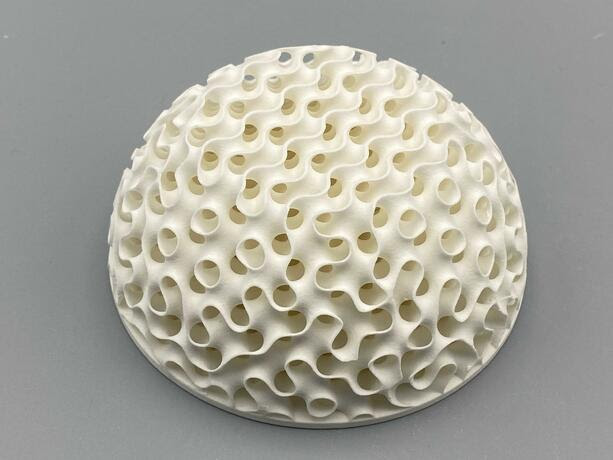Fortify, a 3D printing startup based in Boston, is partnering up with ceramic 3D printed materials expert Tethon 3D to help develop technical ceramics for 3D printing, as well as advance the adoption of ceramics in various AM applications. As some analysts predict, the 3D printed technical ceramics market is just on the verge of a lengthy period of growth, and according to Fortify, the compounded annual growth rate (CAGR) for these materials from now until 2027 is likely to reach 33%. By partnering with Tethon 3D, Fortify hopes to speed up the progression from using conventional methods to manufacture technical ceramics—a current $8 billion market—to 3D printing.
“Expanding our platform to the technical ceramics market is a natural evolution for Fortify. Pushing the envelope with these materials requires processing of highly-loaded, abrasive, and viscous materials. These are the same capabilities that drive our success across various technical photopolymers,” explained Joshua Martin, CEO and Co-Founder of Fortify. “Tethon 3D is an ideal partner for us based on their ability to quickly formulate materials. We’re excited with what they have been able to accomplish with our technology in-house in just six weeks.”

A 3D printed ceramic Rocket Nozzle printed on the FLUX CORE printer with Low Shrink Aluminum Silicate (LS-AS) resin
Fortify’s patented DCM (Digital Composite Manufacturing) platform combines proprietary systems for mixing and magnetic alignment with digital light processing technology in order to print composite parts with optimized mechanical, electromagnetic, and thermal properties—basically achieving a higher level of part performance by introducing functional additives to photopolymers. Its partnership with Tethon 3D will allow both companies to serve various industrial applications, in addition to classified projects with government agencies.
Earlier this summer, Tethon 3D installed one of Fortify’s FLUX CORE 3D printers in its Omaha, Nebraska development facility, and has been using it, together with the startup’s Flux Developer software, to develop two new materials: Low Shrink Aluminum Silicate (LS-AS) and Fortify High Purity Alumina (HP-A 99.8), which supposedly have the lowest shrink rate of similar materials on the market and will be released at the upcoming RAPID + TCT event in Chicago.
“Working with Fortify to drive new material formulations has been a pleasure. The overall robustness of the FLUX CORE system and the capabilities of Flux Developer to quickly validate multiple variables simultaneously has really shortened our lead time on new materials,” said Tethon 3D’s CTO Greg Pugh. “The key demands from our customers are higher purity materials, low shrink rates, and faster processing through print and sintering. The Fortify partnership advances our technology on each of these metrics.”
There are many applications for ceramic materials, such as environments that require high wear, broad chemical compatibility, and extreme temperatures, and we’ve learned that technical ceramics in particular will continue to work where polymers and metals would have long since failed. Ceramics growth has been typically slowed by manufacturing challenges, but 3D printing makes it possible, and even easy, to fabricate complex geometries out of this class of materials.
By combining Fortify’s advanced 3D printers, which are designed to work with loaded resins, and Tethon 3D’s expert knowledge in formulating high performance technical ceramics for 3D printing, the two US companies can ensure high throughput printing of heavily loaded ceramic materials for producing end-use parts.
“We are excited to partner with Fortify as the ceramics market grows. We have clear demand from our customer base for more production-oriented solutions. Fortify Flux printers are a natural complement to our Bison 1000 DLP printer customers as they look to scale their operations,” stated Tethon 3D CEO Trent Allen.

A 3D printed ceramic GRIN lens printed on the FLUX CORE printer with High Purity Alumina (99.8%) (HP-A 98) resin
You can visit Fortify at Booth #E8652, and Tethon 3D at Booth #E9022, at next month’s RAPID + TCT at McCormick Place, as both companies will be showcasing the various 3D printed ceramics achieved through this new partnership.
Subscribe to Our Email Newsletter
Stay up-to-date on all the latest news from the 3D printing industry and receive information and offers from third party vendors.
You May Also Like
Gorilla Sports GE’s First 3D Printed Titanium Cast
How do you help a gorilla with a broken arm? Sounds like the start of a bad joke a zookeeper might tell, but it’s an actual dilemma recently faced by...
Nylon 3D Printed Parts Made More Functional with Coatings & Colors
Parts 3D printed from polyamide (PA, Nylon) 12 using powder bed fusion (PBF) are a mainstay in the additive manufacturing (AM) industry. While post-finishing processes have improved the porosity of...
$25M to Back Sintavia’s Largest Expansion of Metal 3D Printing Capacity Since 2019
Sintavia, the digital manufacturing company specializing in mission-critical parts for strategic sectors, announced a $25 million investment to increase its production capacity, the largest expansion to its operations since 2019....
Velo3D Initiates Public Offering in a Bid to Strengthen Financial Foundations and Drive Future Growth
Velo3D (NYSE: VLD) has been among a number of publicly traded 3D printing firms that have attempted to weather the current macroeconomic climate. After posting a challenging financial report for 2023,...
































